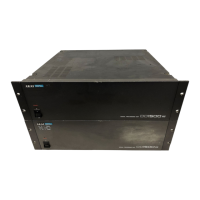APPENDIX 1
Version 2.00 - March, 1996 Page 279
NOTES REGARDING THE USE OF MULTIPLE DISK DRIVES
The DD1500 can have several disk drives on line at any one time and these may be a
combination of fixed hard disk drives or removable disk drives. The DD1500 can play
audio from any disk at any time. Furthermore, a single project can access audio from any
disks that are on-line. For example, a project could be playing music from one disk, sound
effects from another, foley from another and dialogue from another. However, please note
that when using removable disks (i.e. MO disks), it is vital that the correct disks accompany
the project if it is transferred elsewhere. In the above example, if the disk containing the
foley did not accompany the project when it is transferred to the mix down room, the foley
would not play. In this case, when you load the project, the cues that refer to audio on the
other disk (i.e. the foley cues) would be shown in a bright yellow indicating that the audio is
missing. However, you will note that the rest of the project will play correctly - you simply
won’t hear the foley cues until that disk is put on-line.
You will note, however, that there is no restriction into which drive a removable disk can be
placed. If, on System A, the music disk was on Drive ID#0, the sound effects on
Drive#ID1, the foley on Drive ID#2 and the dialogue on Drive#ID3, they do not necessarily
have be in that order when transferred to another System B (i.e. you could swap all the
disks around and everything would still play perfectly). This allows a lot of flexibility when
transferring disks from one system to another as each system may be set up slightly
differently (for example, one system may use SCSI IDs 0-3 whilst another uses 1-4 and
another uses 0, 2, 5 and 6). In all cases, the projects will play back correctly regardless of
the SCSI ID of the drive any disk is placed in and you won’t have to re-edit projects to
allow for different system configurations.
The only problem you may have is when an MO disk is transferred elsewhere and the
audio becomes ‘detached’ from the project. For example, one way you may be working is
that you regard the removable MO disk as your ‘project’ or ‘work’ disk (i.e. it is your reel of
tape!). You may have on your system a fixed hard disk that contains a large library of
sound effects (organised sensibly into categorised libraries of course!!). You may be
pasting and inserting clips from that large sound effects library into the project on your MO
disk. On your system, everything plays back perfectly but be careful when you transfer the
MO elsewhere - because the actual audio does not exist on the MO, when you
subsequently try to play that MO on another system, although the sound effects cues will
be shown (in bright yellow), they will not sound. In this case, you should run the COMPILE
function to create one master disk before transferring it. This will copy the relevant pieces
of audio being used in the project on the MO from all connected disks to the MO disk.
Basically, what you must remember is that when transferring MO disks from one system to
another, try to ensure that the audio does not get ‘detached’ from the project. Of course,
when you load the project up on another system, you will see immediately that some cues
will not play as they will be shown in bright yellow but, of course, at that point, it may be
too late (or at least inconvenient) to do much about it.
This is not a limitation of the DD1500 but a problem created by the concept of using
removable disks and the same kind of problems exist with anything that uses a
‘transportable’ medium. Of course, it could be argued that when you paste in a clip from a
library on an external disk, you the DD1500 should also copy the audio across with it to
prevent this from happening but it would slow creating and editing a project down
enormously if you had to wait a few minutes as the audio is copied. We think it’s best that
you can work fast, bear the above in mind and then use the COMPILE function to bring
together all the required audio across in one operation. Every step has been taken to
make moving media around as painless as possible but when moving projects created
using multiple drives, please remember the above points.
Please refer to the section SAVING PROJECTS - COMPILE for details on copying files
from one disk to another.

